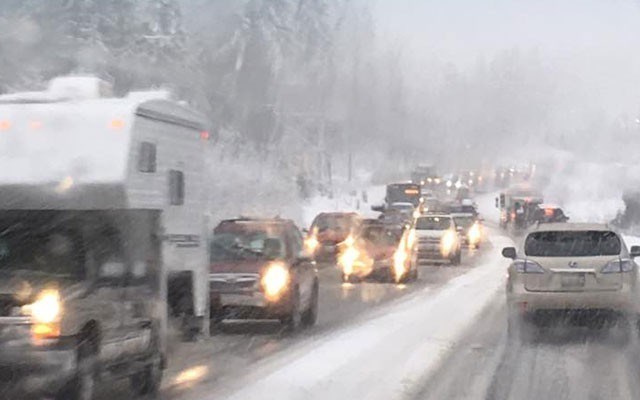While it was nice, sort of, to see visitors come back in historical high numbers after two years of COVID Christmases, the inevitable traffic jams served as a reminder that absolutely nothing has been done to improve the highway situation.
This is a buck that has been passed to the moon and back. All kinds of solutions have been proposed but nothing ever seems to happen, while in some cases the Ministry of Transportation has actually dug in its heels to keep our miserable status quo.
The situation is this: Whistler has one main road—one way in and, at peak times, no way out. It’s just two lanes through the resort, for the most part, with the exception of extra southbound lanes at Village Gate and Creekside that seem to cause as much traffic as they alleviate—and at non-peak times tend to get used as hazardous right-hand passing lanes instead of merge lanes.
One proposal would add a third lane that alternates direction according to traffic patterns, similar to the stretch of road between Park Georgia and the Lions Gate Bridge. In the morning there would be two lanes heading north—one of which could be reserved for carpooling and transit if that’s what we’re pushing for—and in the evenings there could be two lanes heading south to the highway.
Having more lanes worked well during the Olympics, and that stretch of highway has already been widened accordingly, but for some reason the idea of making this option permanent has gone nowhere. The lack of progress is making life a lot harder for thousands of locals—including locals taking transit who end up mired in the same traffic nightmare.
All those new housing units in Cheakamus Crossing are pretty great—for anybody who doesn’t need to go north in the morning or make it home on a Sunday afternoon in less than an hour. By building up that neighbourhood, we’re also adding hundreds of cars to our local traffic during rush-hour periods, which further complicates matters for people in three forgotten neighbourhoods that rely on increasingly rare gaps in traffic to safely pull out.
The three southern neighbourhoods that don’t have traffic lights are Brio, Nordic and Spring Creek. At certain times of day it can take five minutes or more for a gap that allows you to turn left onto the highway.
I live in Spring Creek, and my current record wait to make a left turn is eight minutes. The longest it has taken me to drive to the village was almost an hour, and it once took an hour and a half to make it home—a distance of just over
seven kilometres.
Adding traffic lights at Spring Creek is impossible while the highway speed limit remains at 80 km/h, but even if the speed was lowered it still wouldn’t be considered, because lights create more traffic and, more importantly, there’s an issue stopping vehicles on hills in slippery conditions. People who live in that neighbourhood or drop their kids off at the school could really use either a traffic circle or a dedicated pull-out southbound lane so they can pull out partway when there’s a northbound gap. And slower traffic.
The municipality, and myself, have petitioned the province for years to lower the speed limit to 60 km/h from south of Creekside to Function Junction, but with no success. Apparently the province is comfortable with that speed limit, regardless of how curvy, hilly, or popular the highway is with cyclists. They don’t care that there’s a school and firehall, or that drivers turning left out of Spring Creek can’t see that far up the road. You have a window of about four seconds before the car that appears over the hill is on your bumper.
The speed limit is a more reasonable 60 km/h at Nordic, but otherwise the situation is identical—both entrances are located on hills where vehicles are already prone to spinning out and traffic lights are impossible. At least one traffic circle or pull-out lane for that neighbourhood would be a huge help.
Brio? It’s flat, and a traffic light could be feasible, although I doubt it would be considered because it would add to congestion near the village to stop vehicles in that area. Again, a traffic circle or pull-out lane is the most reasonable alternative.
Traffic circles (also known as roundabouts) are incredibly common in Europe, where entire cities get by with fewer traffic lights than Whistler, but for some reason they never really got a fair shake here. I get it—there are a lot of terrible drivers on our roads that would struggle at first, but circles really do work when it comes to keeping traffic moving.
A third lane and circles—or pull-out lanes if we can’t be trusted with circles—would go a long way to helping people drive in and out of the resort, speed up our transit system, and improve the lives of everyone here. And yet, again, nothing is happening. It’s embarrassing.
At the very least, it’s time to look seriously at night skiing, which would help stagger times that skiers arrive and depart on weekends. Adding upload capacity is a great idea, but changing the way people use the mountains, while creating something to do in the evenings, will do wonders for our traffic situation.




